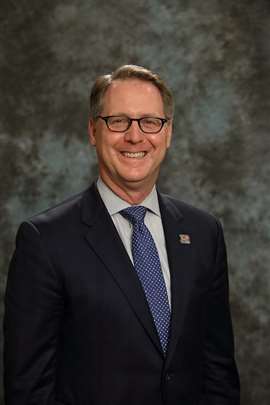Has an obsession with creating graduates strangled supply of construction workers?
02 September 2024
 AI-generated image created with Ideogram 2.0
AI-generated image created with Ideogram 2.0
The fact that construction the world over has a skills problem is, at this point, not much of a surprise.
But a new survey from the Associated General Contractors of America (AGC) has shed light on just how extensive that problem is, at least as far as US construction employers are concerned.
A total of 94% of US contractors report having a hard time filling open positions. More than half (54%) reported that workforce shortages are causing delays to their projects and are more likely to be the cause of delays than other factors like supply chain challenges.
The AGC appears to be in little doubt about one of the main causes of the workforce challenge confronting construction. “Our nation’s failure to invest in construction workforce education and training programmes is having a real, measurable impact on the country’s ability to build infrastructure and other construction projects,” AGC CEO Jeff Shoaf said during a discussion of the situation that included contractors from across the US.
And he suggested that a focus among politicians on encouraging students to pursue a university education – an approach common to a number of developed economies around the world – has harmed the industry by choking off its supply of new entrants.
Government ‘failure’
“One reason it is so difficult for firms to find people is because federal officials have failed to properly invest in construction workforce training and education,” he said.
“A recent report released in partnership with the Progressive Policy Institute found that federal officials invest four times more each year encouraging students to earn four-year degrees than they do supporting workforce development programmes than they do for fields like construction.”
 Associated General Contractors of America (AGC) chief executive Jeff Shoaf (Image courtesy of AGC)
Associated General Contractors of America (AGC) chief executive Jeff Shoaf (Image courtesy of AGC)
In the face of a constricted supply of skilled professionals, the AGC advocates bringing in workers to the US from abroad. But here too, it claims, the federal government is not making life easy.
“Federal officials not only fail to invest in construction workforce development, they also make it difficult for construction firms to take advantage of the very few visa programmes that are available to the industry,” said Shoaf.
The findings chimed with the observations of Latoya Goree Smith, CEO of general contracting and professional services company RhysIvy, based in Kansas City, Missouri.
“The lack of investment in construction workforce education has been going pretty much downhill for quite some time because most politicians are more focused on everyone going to college. But we all know that not everyone is equipped to go to college,” said Goree Smith.
Jami Klomp, human resources manager of specialty foundation and geotechnical contractor Hardman Construction, based in Ludington, Michigan, also agreed with many of the findings of the survey.
“There are people out there who are available but they just don’t have the skills we can utilize on all of our jobs. One of the things we are always concerned about is safety…If you have someone brand new coming into the industry, it does add that extra layer of difficulty for us. We can sit and complain about it all we want, but we do want to be able to figure out how to handle this workforce shortage that we are all experiencing.”
Lack of dedicated HR staff
The AGC’s survey showed that contractors themselves have indeed taken action to do what they can to overcome labour shortages.
In the majority of cases (91% of those surveyed) that comes in the form of increased base rates of pay for hourly construction positions over the past year. A total of 57% of companies also reported that they have added online strategies to recruit younger workers and 51% have engaged with career-building programmes like high schools or training facilities.
They are also investing in internal training to address a lack of hard and soft skills (reported by 42% of firms) and turning to online learning programmes (26%), or using human resources technology to deliver training programmes for workers (25%).
Such measures are important since 22% of construction companies indicated in the survey that they don’t employ dedicated human resources staff, said Carrie Gardenhire, director of association partnerships at construction HR software provider Arcoro.
“Software like ours to automate the job distribution and hiring process is a significant opportunity for contractors to leverage tech to help with workforce issues,” she said.
Highlighting one of the survey findings that over 50% of respondents said their new hires either don’t show or quit very quickly, she said, “Applicant tracking and onboarding technologies can help by streamlining this process to optimize the employee experience from the get-go. Even when a firm employs HR staff, we hear from people with HR responsibility that they spend a significant amount of their time on administrative tasks like filling in time sheets that really limits their capacity on recruiting, company culture and retention, leading directly to that costly turnover.”
For its part, the AGC and its network of 89 chapters has run more than a dozen targeted digital advertising campaigns designed to recruit new workers, according to Shoaf. The organisation has also shared resources and templates for recruitment, as well as its ‘Culture of CARE’ programme for contractors as a means of boosting retention levels.
Taking matters into their own hands
Goree Smith pointed to developers and contractors sponsoring workforce training programmes on large projects around Kansas City. And she emphasised that rather than just pure workforce training, there needed to be a holistic approach to support individuals to gain entry into the field, who may need help with basic skills like numeracy or even with personal struggles like a lack of transportation to and from jobsites. She also highlighted the need for collaboration with unions, particularly in areas where there is strong union organisation like in Kansas City.
Klomp agreed that good relations with union partners are important and explained how Hardman Construction has developed a mentorship and training programme.
“A few years ago we took a step back because we could see there was going to be an issue with workforce. We just threw everything at the wall to see what would stick. We have started focusing more on retaining those individuals coming into our organisation,” she explains.
 Image: AI generated by chaoticmind via AdobeStock - stock.adobe.com
Image: AI generated by chaoticmind via AdobeStock - stock.adobe.com
“We might have a new apprentice who comes to us with no prior construction experience. We spend a week with them just learning the bare basics at our home office and they are getting safety training at the same time. And then there’s a whole group of people out in the field who care about them.”
The situation at RORE Construction, an approved military construction contractor based in San Diego, California, is a little different as its founder Dr Gita Murthy explained.
For her company, one of the biggest challenges is in fact that federal clients put stringent limitations on who can be qualified to undertake work in certain posts on a contract. “The Navy, for example, requires your quality control person to have a four-year bachelor’s degree,” she says.
“It’s crazy because a lot of the quality control folks have experience and they don’t have college degrees. If we are unable to fill that position, the owner has no leniency. I don’t see it going away in the near term and it is going to take a lot of parties to come together, including the owners, and brainstorming a solution.”
In the meantime, the company is reaching out to veterans as a potential pool of labour. “We are reaching out to the San Diego Military Advisory Commission but the challenge there is San Diego is a pretty expensive city to live in. In order for us to keep people, base salaries are very high. We are trying to meet the high salaries yet win bids on lowest price. It’s crazy.”
Industry efforts alone ‘not enough’
In spite of the positive initiatives going on within the industry, Shoaf contended that on their own they are “not enough to counter the massive federal funding imbalance when it comes to workforce development.”
He called on the federal government to adopt better workforce policies and for more funding for construction-focused education and training.
He identified two opportunities to do that: An increase in the amount of money allotted to training in the Workforce Investment and Opportunity Act and an increased amount of money dedicated to school construction education programmes when the spending levels under the Perkins Vocational and Technical Education Act are set later this year.
He added, “It will take time for these new funds to rebuild the domestic pipeline for preparing future construction professionals. That is why Washington officials also need to enact programmes that will allow more people to enter the country lawfully to work in construction.
“The bottom line is the federal government needs workforce policies that support instead of undermining national infrastructure and economic development priorities.”
STAY CONNECTED



Receive the information you need when you need it through our world-leading magazines, newsletters and daily briefings.
CONNECT WITH THE TEAM








